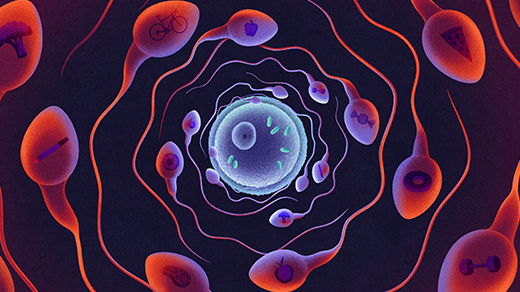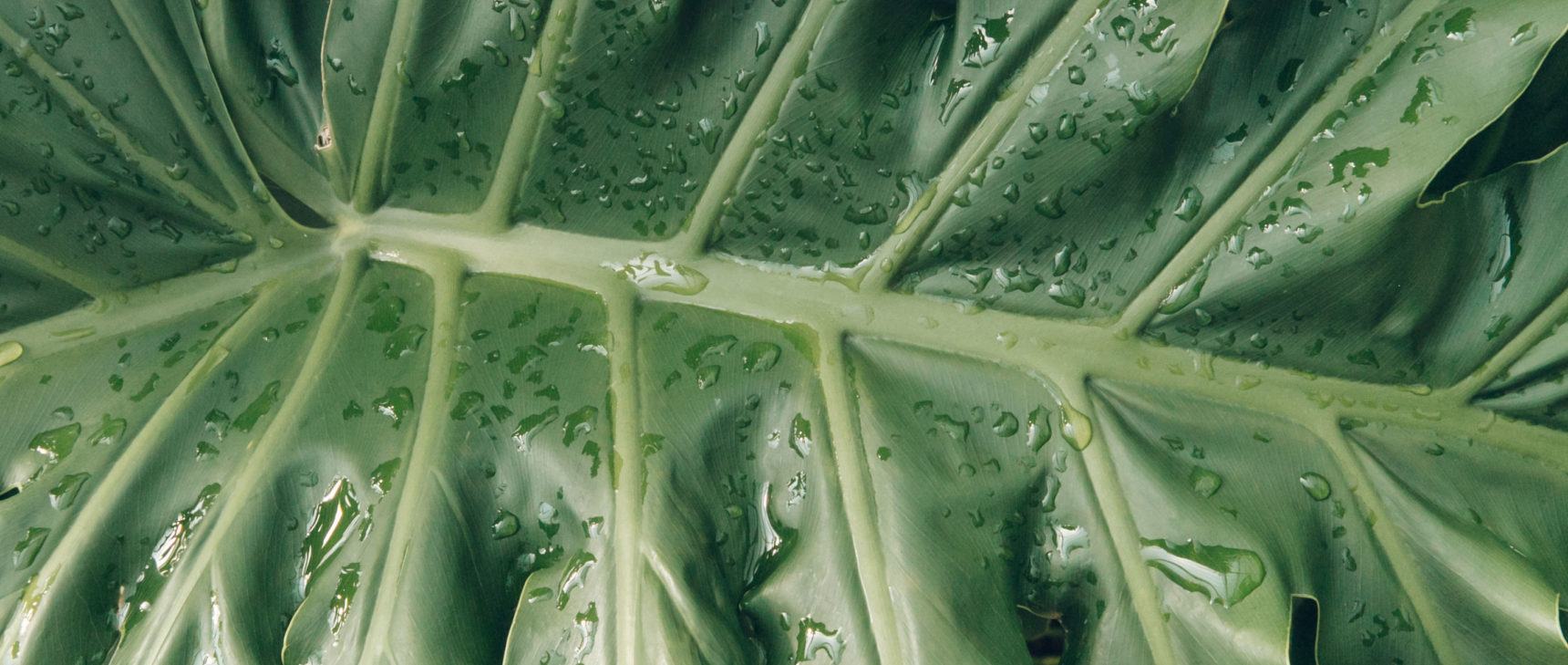
DNA Analysis Reveals a Genus of Plants Hiding in Plain Sight
Haarkon for Quanta Magazine

This beautiful specimen growing at the Royal Botanic Gardens Kew is Thaumatophyllum bipinnatifidum. Until earlier this year, however, it was classified as part of the genus Philodendron. The change in the plant’s taxonomy came with a deepening understanding of how greatly it differs from most members of Philodendron, particularly at a genetic level.
Haarkon for Quanta Magazine
Introduction
For centuries, biologists have used taxonomy to sort living things into groups based on appearance, behavior and other perceptions of identity. They have christened plants and animals with binomials rooted in Latin and Greek that often allude to their distinctive macroscopic features. Beyond their usefulness in identification, those categorizations and name choices reflect prevailing theories about the relationships among forms of life, and what distinctions are meaningful in the organization of nature.
It’s astonishing that taxonomic categories for plants created hundreds of years ago — often based only on dried, discolored and flattened herbarium specimens that just barely resemble their living counterparts, and sometimes based on no more than a drawing — have been confirmed by modern genetic standards as often as they have. Yet important exceptions still occur, even for very familiar plants you might see every day in your home, and they testify to the potent influence of molecular biology and other technologies in modern systematics.
Consider the case of a certain common specimen of big, tropical-looking plant with serrated leaves that you might know as the lacy tree philodendron, or as the split-leaf philodendron. But common names can often refer to dozens of plants, so if you’re a botanist or serious plant maven, perhaps only its scientific name, Philodendron bipinnatifidum (or its synonym, P. selloum), will do.
The last part of the name P. bipinnatifidum denotes the plant’s species (the most specific group in which it can be placed), but also describes some of its characteristics. The word is an amalgam of bis, meaning “twice” or “double”; pinna, for “feather”; and findo, meaning “to split” — befitting a group of plants with bilaterally symmetrical, feathery, split leaves. Philodendron refers to the genus: a broader grouping that encompasses many species, derived from the Greek philos, “to love,” and déndron, or “tree,” probably because in nature many of these plants spend much of their lives climbing trees. Philodendron belongs in turn to an even larger taxonomic family called Araceae, which encompasses all the plants that since antiquity have been called aroids: leafy tropical plants with clusters of multitudinous tiny flowers that grow on a spikelike structure called a spadix, sheathed by a modified leaf called a spathe. Even someone who has never seen P. bipinnatifidum but knows the significance of its taxonomy might pick it out of an assortment of other plants because its name is so rooted in its appearance and habits.
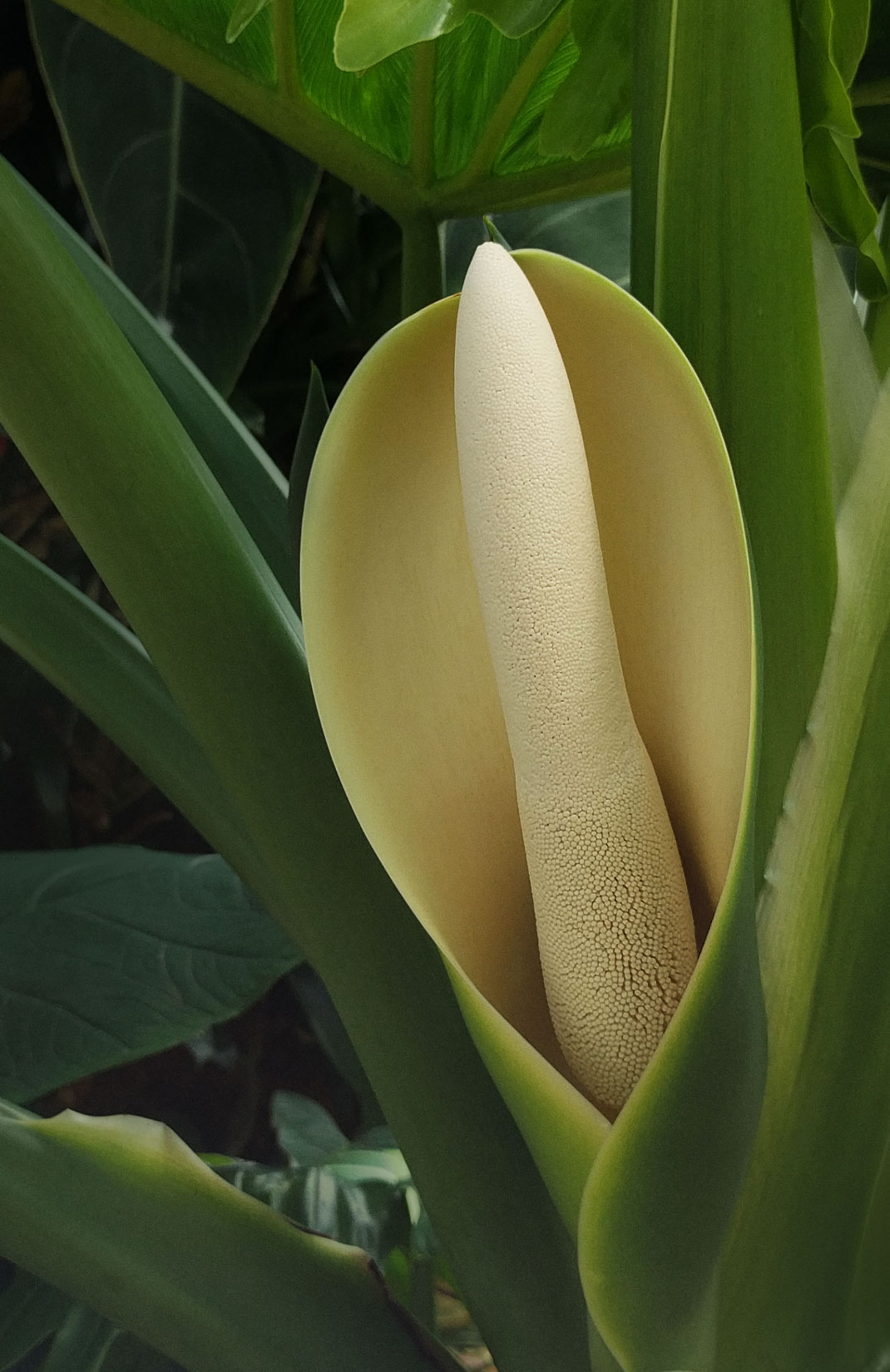
What looks at first like a flower on T. bipinnatifidum is really an inflorescence: a multitude of tiny flowers growing on a spikelike structure called a spadix and protectively sheathed by a modified leaf, the spathe.
Olena Shmahalo/Quanta Magazine
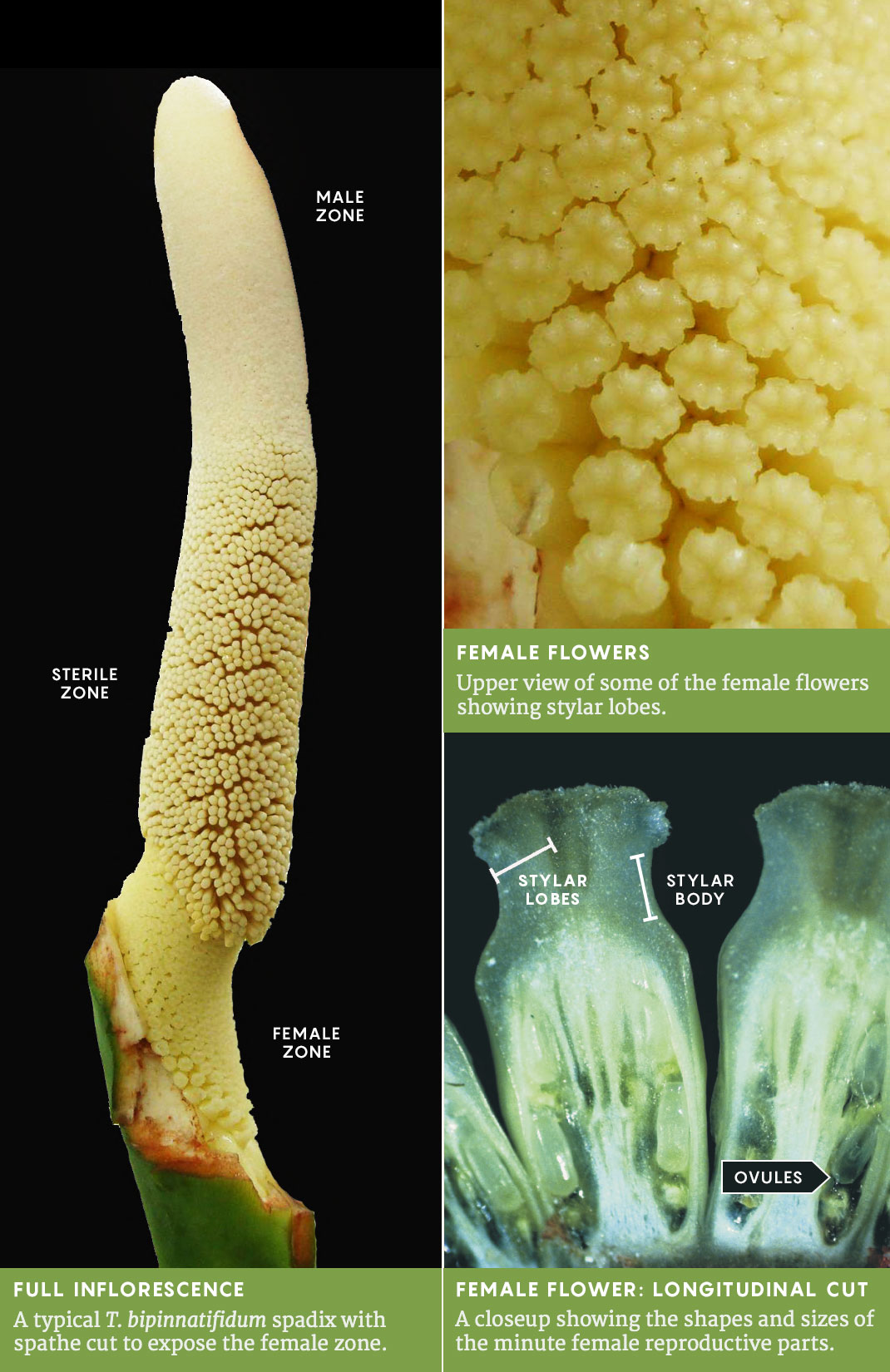
Microscopic details of structures in the individual flowers on the spadix help botanists differentiate this species of plant from those in the Philodendron genus.
Cassia Sakuragui, Federal University of Rio de Janeiro.
What looks at first like a flower on T. bipinnatifidum (at left) is really an inflorescence: a multitude of tiny flowers growing on a spikelike structure called a spadix and protectively sheathed by a modified leaf, the spathe. Microscopic details of structures in the individual flowers on the spadix (three photos at right) help botanists differentiate this species of plant from those in the Philodendron genus.
Olena Shmahalo/Quanta Magazine;
Cassia Sakuragui, Federal University of Rio de Janeiro.
But what does it mean when the name of a thing we all thought we knew, like P. bipinnatifidum, suddenly changes?
Sometimes, a name change is inconsequential: A rose is still a rose. In the case of this feathery Philodendron, however, something important has changed: the depth of knowledge about the plant. Philodendron bipinnatifidum Schott ex Endl. was given its name early in the 19th century by the Austrian botanist Heinrich Wilhelm Schott and was validated by his friend and contemporary Stephan Ladislaus Endlicher in 1837. (The last part of the full scientific name honors them.) At the time, botanists had to rely exclusively on morphology, the study of organisms’ forms, when populating the nebulous category of its genus. Yet genus is a frustratingly shaky rung on the taxonomic ladder, not so sharply defined as species (which poses its own challenges), but still less broad than family.
Although biologists sometimes disagree about how to define species or whether a uniform definition applies across all organisms, species exist in nature as populations of real organisms. A genus, like other higher-order taxa, needs to be inferred from the available evidence and is therefore a bit more abstract, vulnerable to incomplete information and subjective judgments.
Today, however, molecular biology is helping to put definitions of genera (the plural of genus) on more solid ground. Digital technologies are also beginning to make it easier to reliably identify and classify rare specimens in remote areas. The recent reassignment of P. bipinnatifidum to a new genus offers a useful glimpse of forces that have been quietly transforming taxonomy and systematics.
The word genus, meaning “kind” or “stock,” goes back to at least 16th-century Latin. The Swiss botanist Gaspard Bauhin was one of the first on record to use the term. In his text from 1620, Pinax theatri botanici (The Illustrated Exposition of Plants), in which Bauhin defined thousands of plant species, he explicitly distinguished between genera and species. It wasn’t until nearly a century later, however, that genus was defined scientifically for plants by the French botanist Joseph Pitton de Tournefort. In his 1694 book Eléments de botanique, ou Méthode pour reconnaître les Plantes, he grouped nearly 7,000 plant species into about 700 genera. Although Tournefort’s definition, based on the morphology of flowers and fruit, was subsequently found to be superficial, the book was popular and botanists continued to use the names Tournefort defined.
Carl Linnaeus, often hailed as the father of modern taxonomy, popularized the word genus further, midway through the 1700s. Linnaeus kept many of Bauhin’s original names when developing his own taxonomic system, and some of them are still in use even today. (Bauhin is fittingly memorialized with his namesake Bauhinia, a genus of flowering trees within the bean family, Fabaceae.)
But much has changed since the days of the original naturalists. The rising importance of the theory of evolution to biology altered the purpose of taxonomy. Taxonomy began simply as a way of naming and cataloging organisms by form, often in keeping with philosophies about a “great chain of being,” a divine hierarchy that held all life. Today’s biologists, however, want systematics and taxonomies to reflect what is understood about evolutionary history, or phylogeny, and the relatedness of different groups.
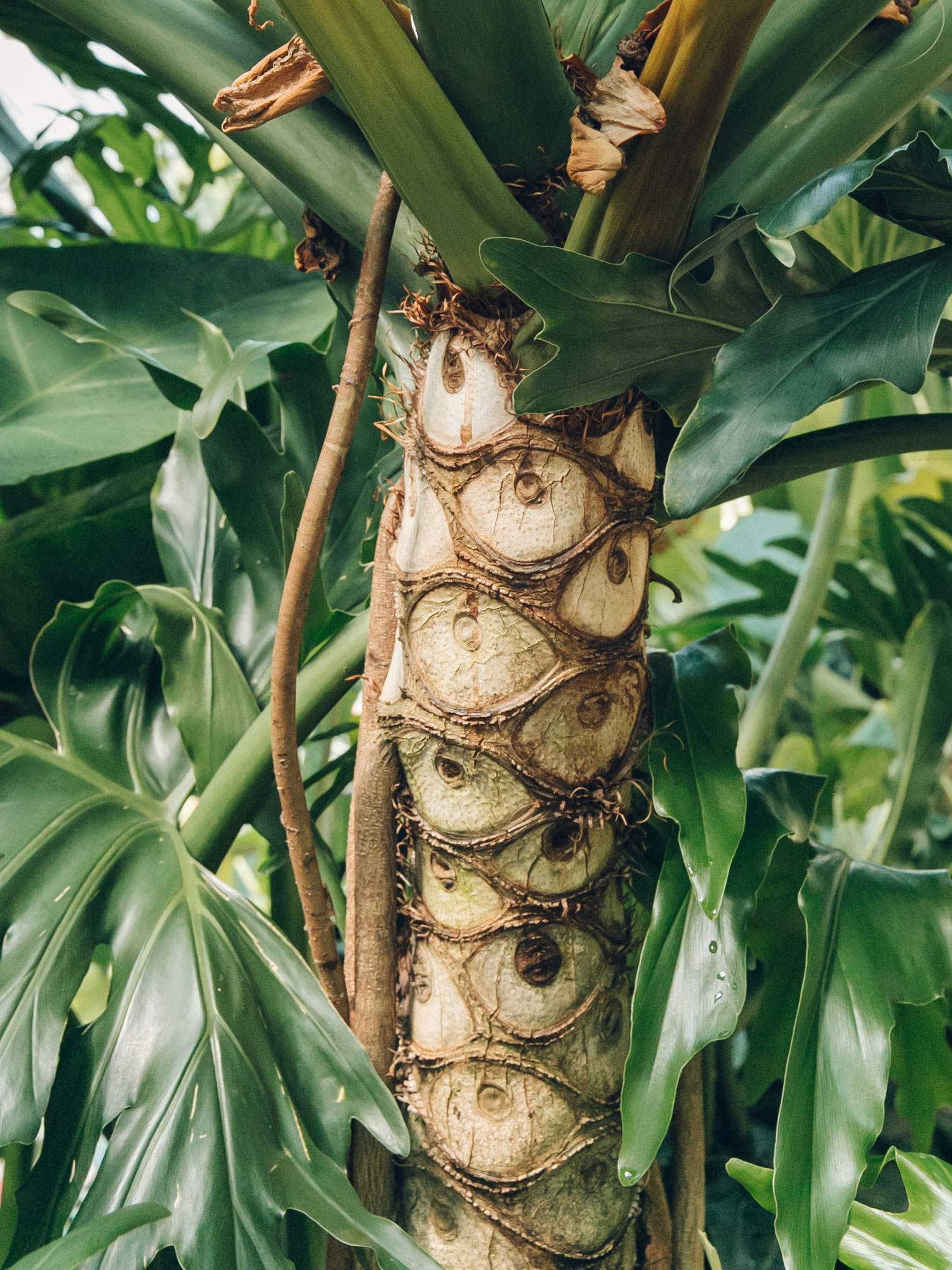
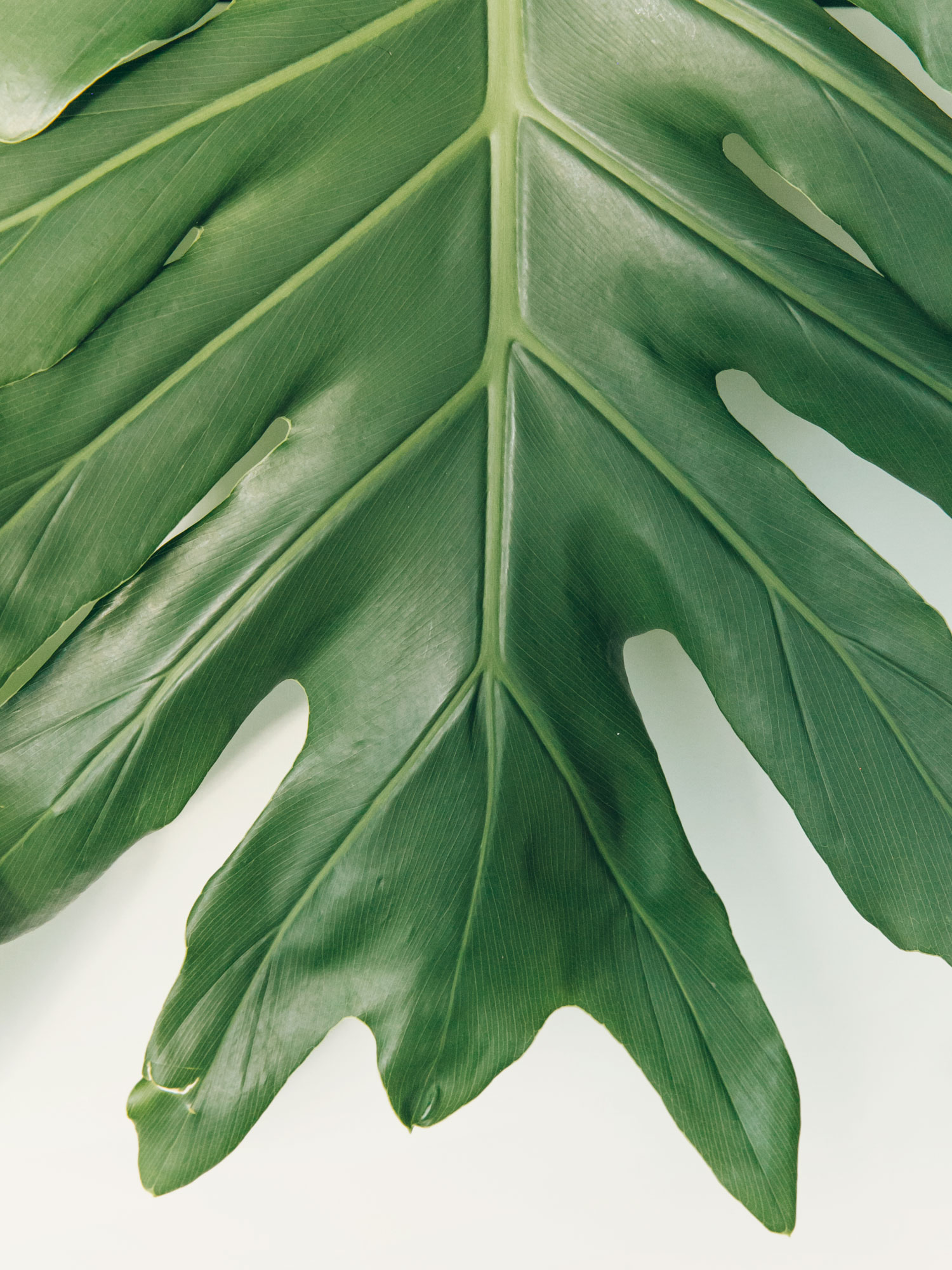
As Thaumatophyllum species grow, they shed leaves and create a kind of trunk (top) that allows them to compete for sunlight without climbing trees in the same way that philodendrons do. Details present in the “trunk” and leaves of these species are important to differentiate it from other genera, but many species share similar leaf shapes across genera and change their leaf shape as they mature (some even becoming unrecognizable as the same species). The inflorescence is consequently a more reliable metric.
As Thaumatophyllum species grow, they shed leaves and create a kind of trunk (left) that allows them to compete for sunlight without climbing trees in the same way that philodendrons do. Details present in the “trunk” and leaves of these species are important to differentiate it from other genera, but many species share similar leaf shapes across genera and change their leaf shape as they mature (some even becoming unrecognizable as the same species). The inflorescence is consequently a more reliable metric.
Haarkon for Quanta Magazine
Striking developments have also arisen from modern biologists’ technologically improved abilities to detect microscopic and molecular features of life that were once unknown. Because of the discovery of DNA and the invention of advanced imaging technologies, the genus category now has a much more meaningful and objectively validated role to play: It allows organisms to be grouped within a common family tree based on their evolutionary lineage rather than just their outward appearance.
Because of such DNA-based insights, Philodendron bipinnatifidum (along with a number of other closely related species) was moved into a new genus and became Thaumatophyllum bipinnatifidum. Its genus label changed from “lover of trees” to “miraculous leaf.” That might seem like an odd choice, given that the plants in this genus shed their leaves as they grow upward, creating a treelike trunk. But the name change helps to distinguish this group of plants from many of its more distant cousins that climb trees to get closer to sunlight.
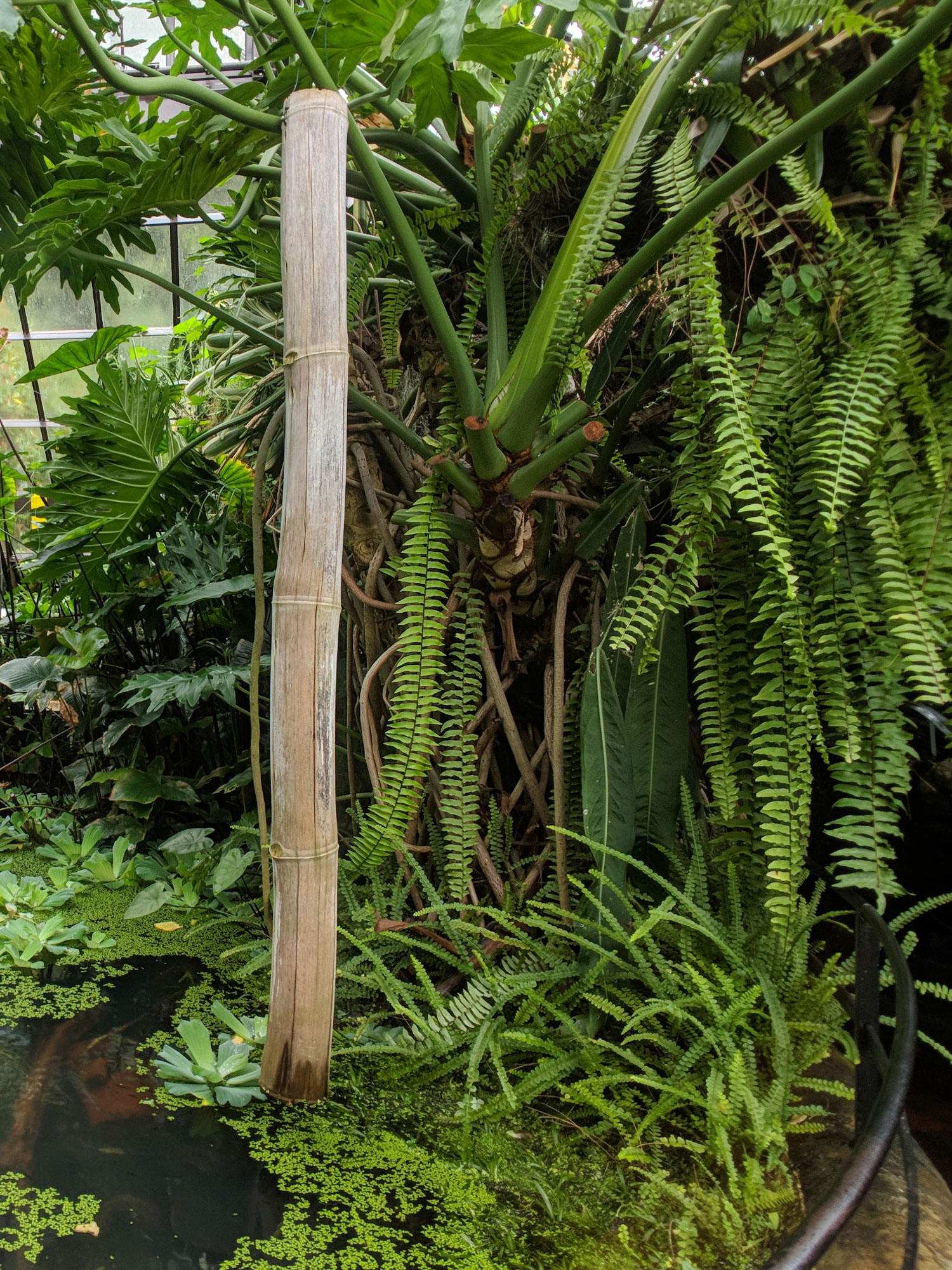
A specimen of Thaumatophyllum bipinnatifidum (above and below) grows near water at Glasgow Botanic Gardens in Scotland. It uses its multitude of strong roots to create a base around the rail and platform, much as members of this genus do in nature.
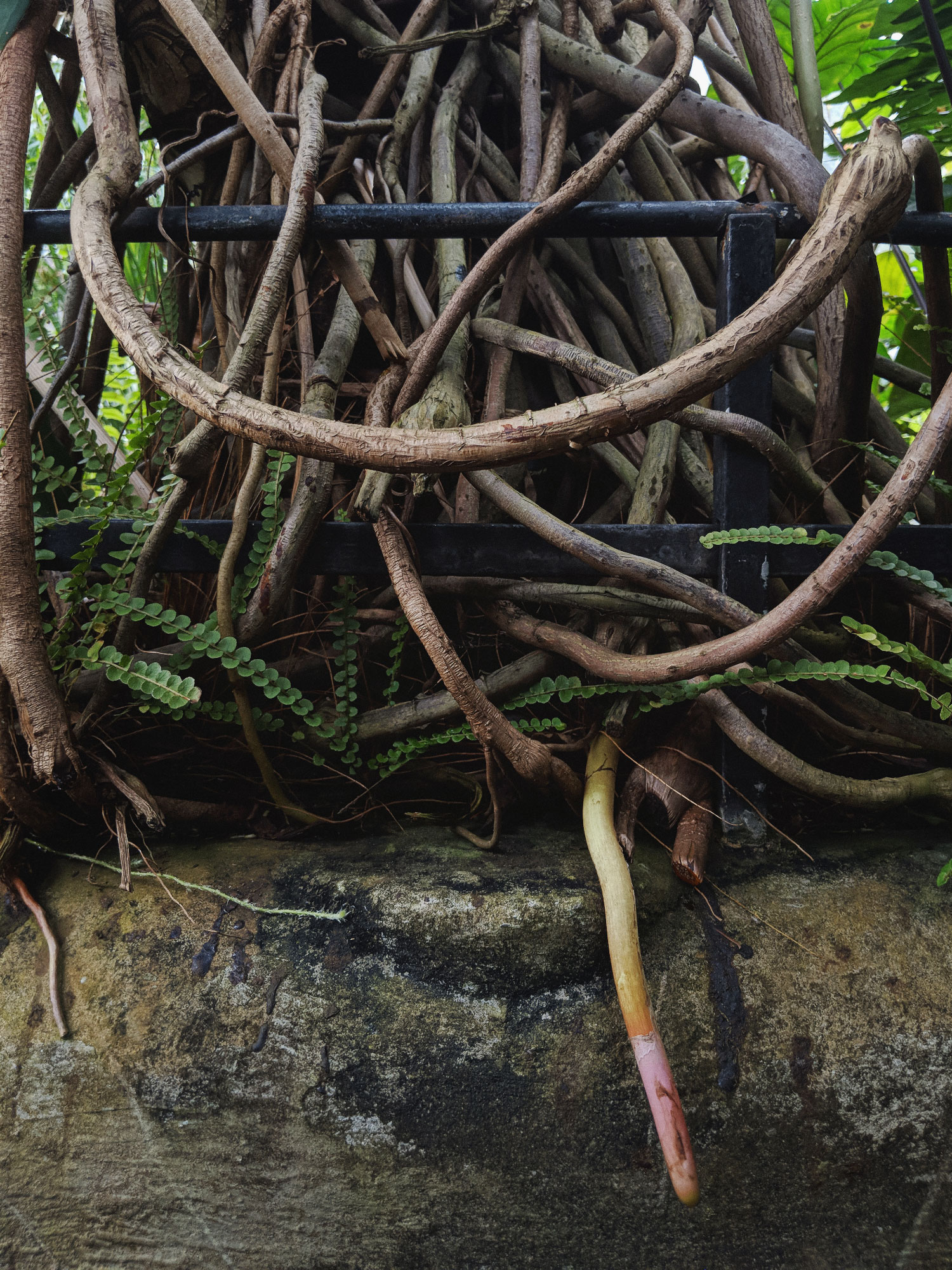
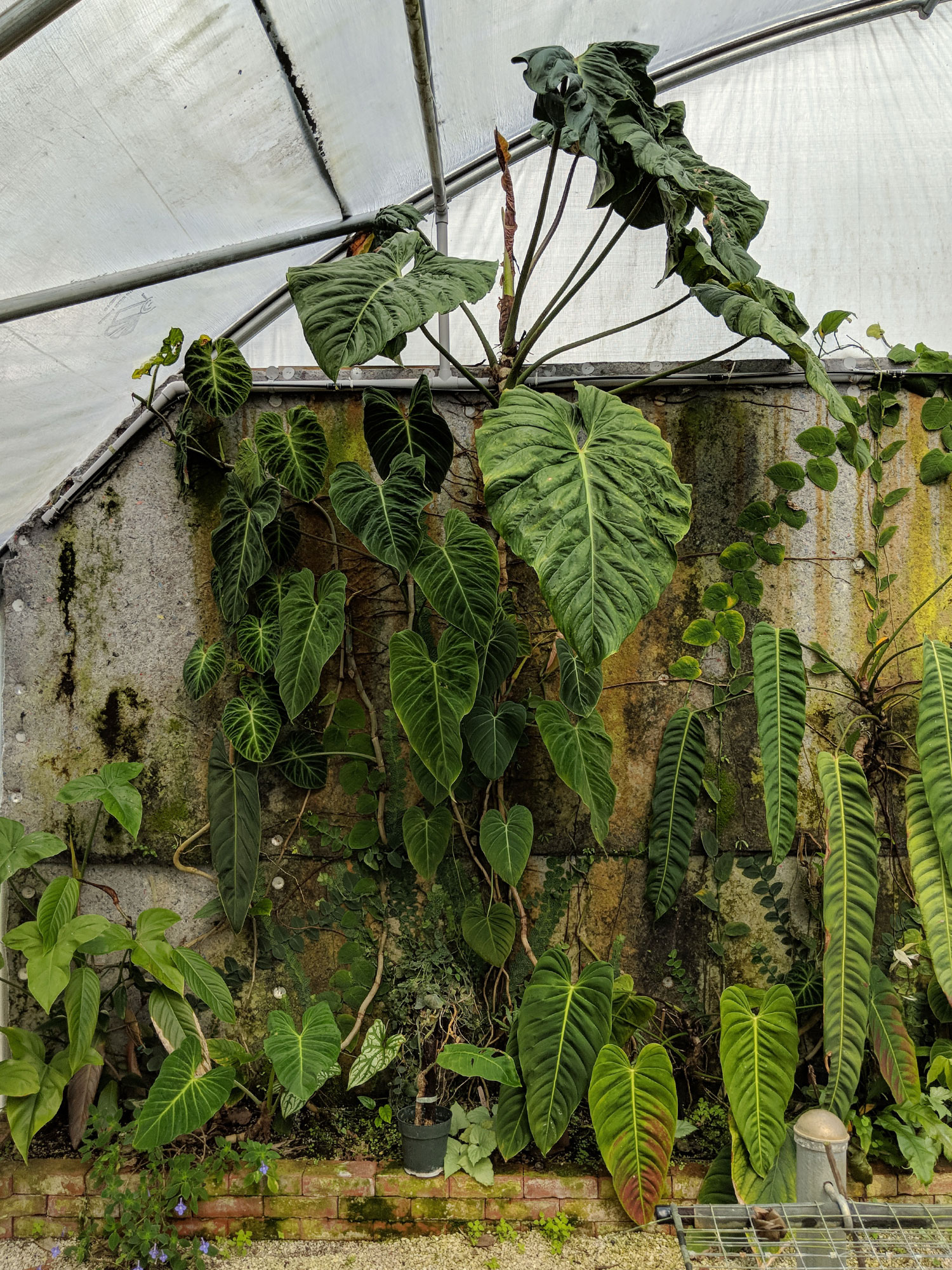
Above, several species of Philodendron use their roots very differently, to climb a wall in a Florida greenhouse.
A specimen of Thaumatophyllum bipinnatifidum (at left and center) grows near water at Glasgow Botanic Gardens in Scotland. It uses its multitude of strong roots to create a base around the rail and platform, much as members of this genus do in nature. On the right, several species of Philodendron use their roots very differently, to climb a wall in a Florida greenhouse.
Olena Shmahalo/Quanta Magazine
Thaumatophyllum is not a new name at all. For many years, it was an awkward genus composed of a single species — Thaumatophyllum spruceanum, named for Richard Spruce, the botanist who collected it in the Amazon region in 1851. Even Spruce himself wasn’t confident that he’d labeled it correctly: In his 1860 book Prodromus Systematis Aroidearum, his description of the plant sits under the heading “Aroidea dubia” — “doubtfully an aroid.”
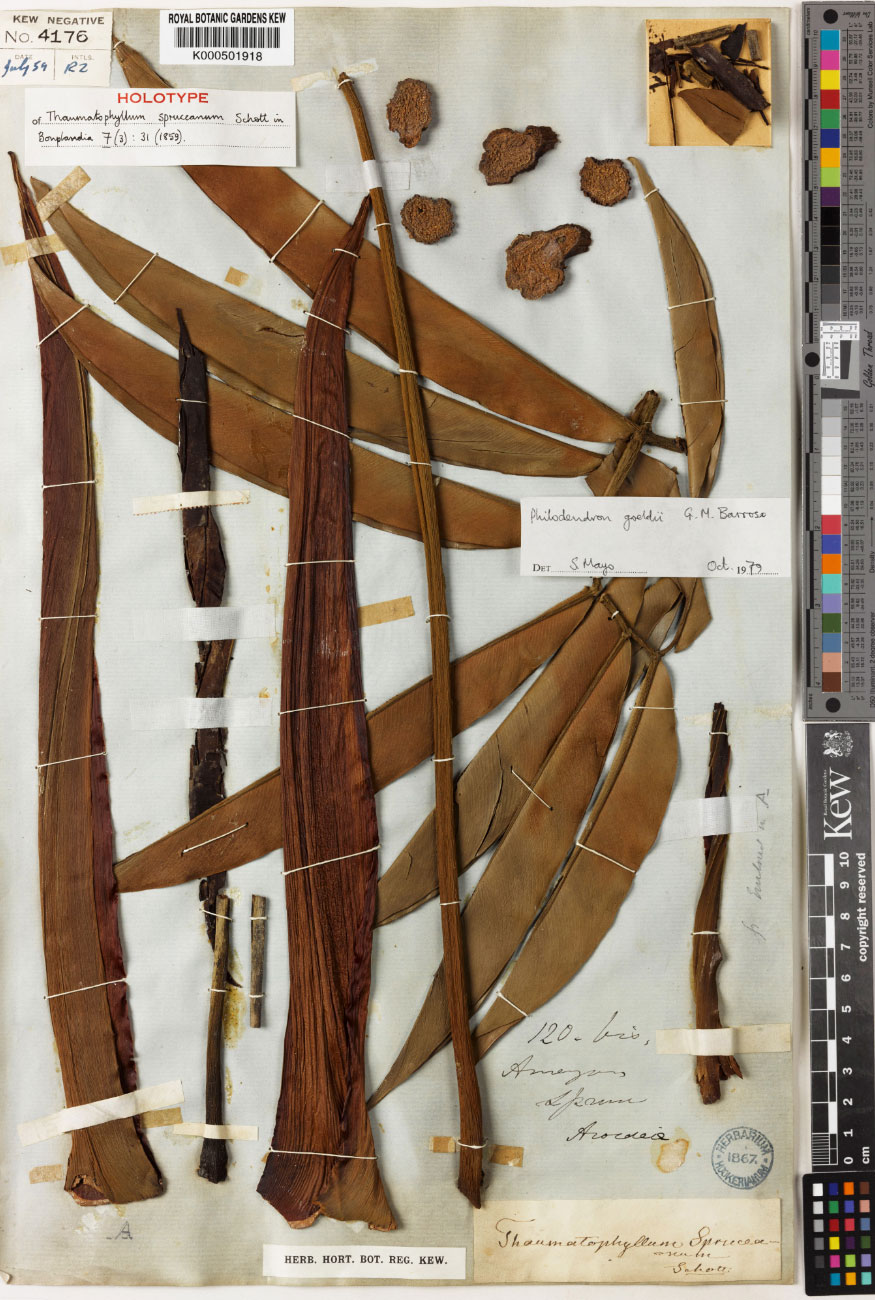
The original specimen of Thaumatophyllum spruceanum that Richard Spruce collected in the Amazon in 1851, which for decades was the only member of the Thaumatophyllum genus, is preserved at the Royal Botanic Gardens Kew in London. The collection and preservation of herbarium specimens like this one are still an important practice in botany.
© The Board of Trustees of the Royal Botanic Gardens, Kew. Reproduced with the consent of the Royal Botanic Gardens, Kew.
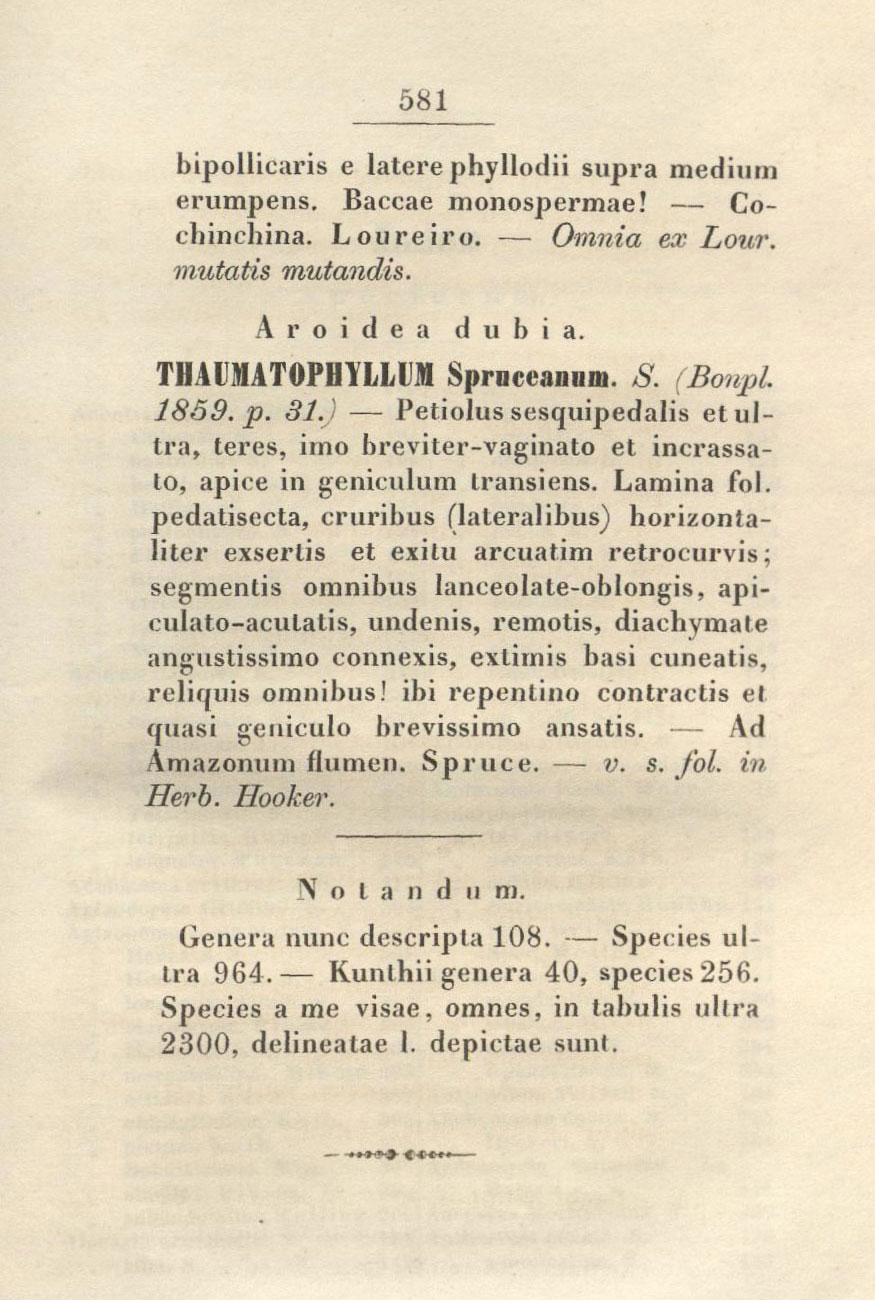
The page describing the find in Spruce’s Prodromus Systematic Aroidearum from 1860 reflected the uncertainty that even he had about this specimen: The heading “Aroidea dubia” means “doubtfully an aroid.”
Prodromus Systematis Aroidearum, Schott, H.W. (Heinrich Wilhelm)
The original specimen of Thaumatophyllum spruceanum (left) that Richard Spruce collected in the Amazon in 1851, which for decades was the only member of the Thaumatophyllum genus, is preserved at the Royal Botanic Gardens Kew in London. The collection and preservation of herbarium specimens like this one are still an important practice in botany. The page describing the find in Spruce’s Prodromus Systematic Aroidearum from 1860 [right] reflected the uncertainty that even he had about this specimen: The heading “Aroidea dubia” means “doubtfully an aroid.”
Specimen: © The Board of Trustees of the Royal Botanic Gardens, Kew. Reproduced with the consent of the Royal Botanic Gardens, Kew.
Page: Prodromus Systematis Aroidearum, Schott, H.W. (Heinrich Wilhelm)
Much later, several prominent botanists attempted to pin down the slippery taxonomic status of Thaumatophyllum and its similar Philodendron cousins. In 1979, Graziela M. Barroso, who was a prominent botanist at the University of Brasilia and Brazil’s most accomplished taxonomist, and Simon Joseph Mayo, the curator of the Araceae collections at the herbarium of the Royal Botanic Gardens Kew, made progress when they discovered that Spruce’s original specimen was identical to another contested aroid species, Philodendron goeldii. They moved the plant over to the Philodendron subgenus Meconostigma.
That reclassification left Thaumatophyllum as simply a synonym of Philodendron, and it had to wait several more decades to become relevant again. The tools needed to dive further into the analysis of phylogenetic data would not exist until the 1990s.
Most recently, new insights have emerged from a research group led by Cassia Sakuragui at the Federal University of Rio de Janeiro. Sakuragui’s group has been working on deepening the knowledge base about these Philodendron plants, including new insights into their ecological, geographical and morphological features. Early this year, DNA evidence confirmed what the plants’ observable features could only hint at: Corresponding genetic sequences analyzed and set into cladograms (which are essentially family trees for taxonomic groups) showed that the species in Meconostigma form a distinct branch that warrants treatment as a new genus separate from Philodendron.
According to Mayo, there is “a strong justification” for recognizing a group of species as making up a novel genus when statistically robust molecular analyses can identify those species as being “monophyletic,” or having a common ancestor, and having distinctive morphological characteristics. In this case, because the species transiently known as P. spruceanum/goeldii was part of that group, the researchers resurrected the name Thaumatophyllum, since it was a genus recognized in the valid literature. The individual species kept the second word of their binomials for simplicity.
In this way, Sakuragui’s molecular findings moved an entire group of plants to a new genus. Although molecular data takes considerable time and effort to collect, the process is now commonplace and essential in systematic work. “Proposing new arrangements of species into genera or subgenera only with morphological evidence is no longer considered adequate by many taxonomists,” Mayo explained by email. “[M]olecular data and their analysis provide the strongest evidence.”
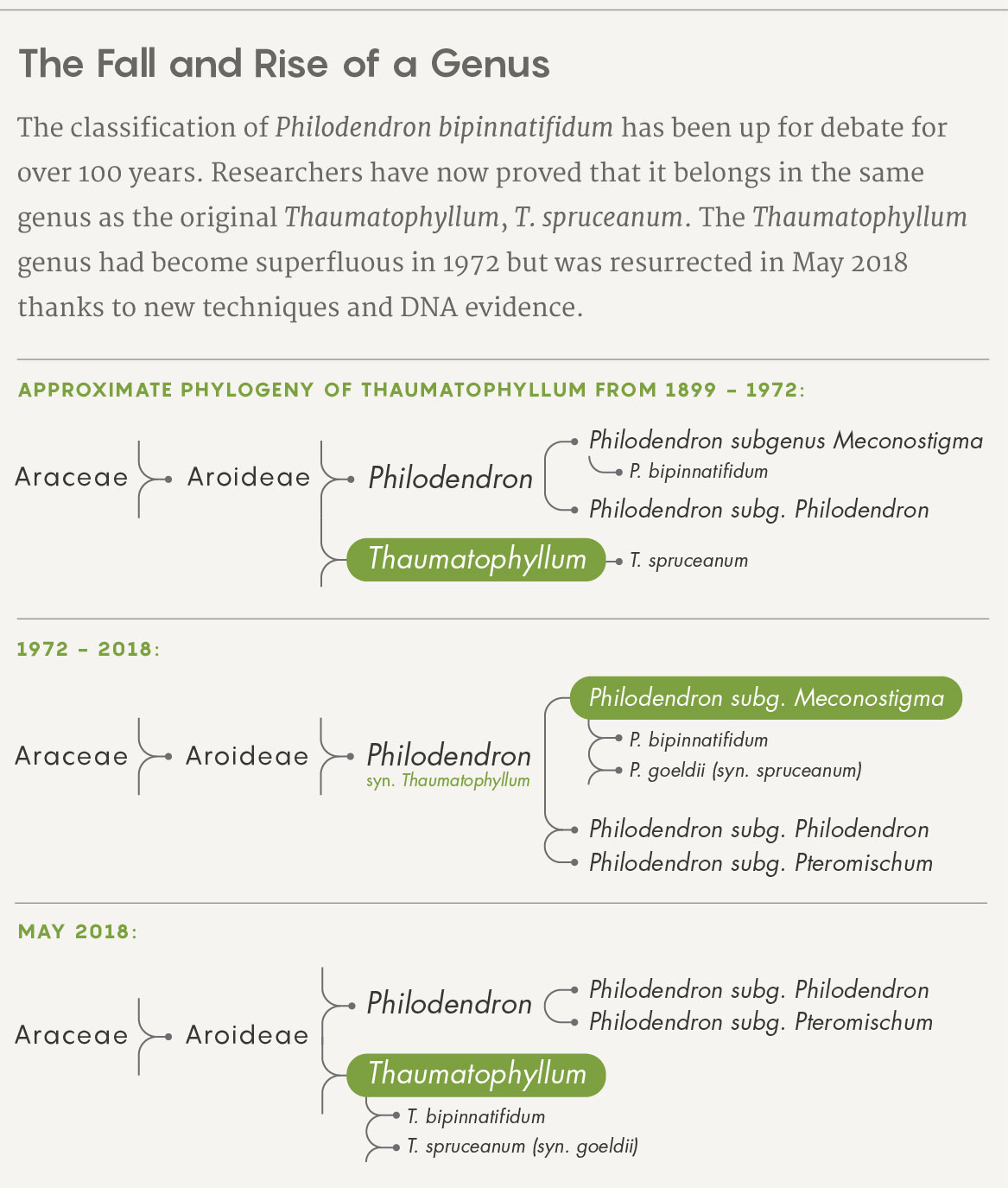
Olena Shmahalo/Quanta Magazine
The advent of molecular methods of analysis has also opened up the possibility of what’s called DNA “barcoding”: extracting short but definitive snippets of an organism’s DNA for use as an identifier of that species. Barcoding is still a new technology, but it’s promising. It should provide taxonomists not only with another way to categorize plants, but also a way to identify specimens based on comparisons with existing, archetypal barcodes. Ideally, such barcodes would do away with the need for a live, flowering or fruiting plant specimen to make an accurate assessment. With only a tissue sample, a specimen’s DNA could be digitally analyzed and compared with any existing resources, globally.
Although taxonomic molecular analysis has gone from nonexistent to obligatory, technology has not yet replaced the human talent for pattern recognition. Traditional methods of identifying and classifying organisms are still part of the process, and herbarium specimens are still used for archival purposes and study. Many institutions now have digitization programs that scan physical plant specimens and add accompanying metadata to online records, which can make it easier for anyone around the world to find those specimens. Illustrations also still serve a purpose. A botanical illustrator can deliberately separate and highlight important parts of plants that may be difficult to see in the flattened version of life that a camera or a scanner is capable of rendering.
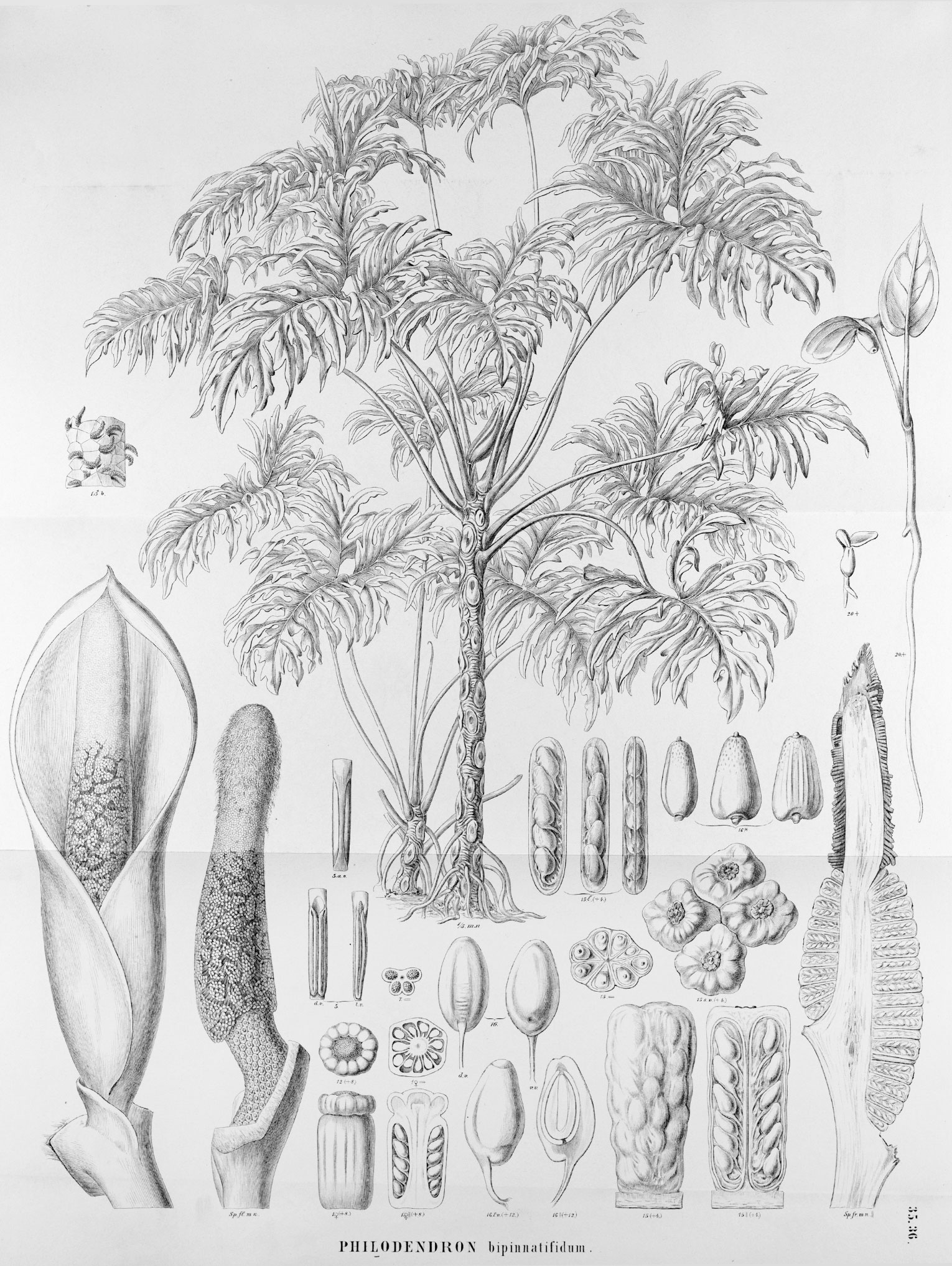
Featured in the book Flora Brasiliensis from 1840, this drawing of what was then called Philodendron bipinnatifidum was situated opposite a separate illustration of Philodendron selloum, which we now know to be the same species.
Taxonomy also still relies on a botanist’s sensory and analytical skills. Plants still need to be identified on the basis of their morphological features, growth patterns and other behaviors, as well as their ecological and geographical distribution. (A mystery plant found in Peru is most likely not the same species as one native to Malaysia, no matter how similar they look.)
“I know of no field survey that could be done with molecules, whereas I readily recognize most species in an instant,” remarked Thomas Croat, a curator of research at the Missouri Botanical Garden, via email.
Croat has decades of aroid identification, collection and research under his belt, having contributed countless specimens to herbariums around the world. “The real drawback to DNA fingerprinting,” according to Croat, “is that while this works to separate different taxa, it is completely disconnected to the naming process. It could tell you that you have 20 distinct species and possibly even four varieties, but it would provide the name for none of them.”
DNA sequences of several Thaumatophyllum species — T. adamantinum, bipinnatifidum, solimoesense and spruceanum — provided by Cassia Sakuragui of the Federal University of Rio de Janeiro.
C C T G T T T T C G T G C A G G C G A C C G C G A G T G C G A T G G G A C G C T T C G T T C G G A A G A T C T C G A G A C T G C G G C T C G G C A T A T T C G G T G G G T T G T A T C G C A T A G C C G A G A T G T G G C G A C T C G G T C A C C C T A C G T T A G T A A C G T G C C G T T C T A C T C T C T C G C T C C C C T C G G G G C G G G C G A G A A G C G A G A A G A G C G G C C C C C T T G C G A C G T C C A G T G C G T C C T C G G C G G C G C G T G C C G C C T G C C T G C A C C G T T G C G T G C G T G C G G C G T G C T T G C A C C G T C C G G C C C T C G G G A C C G T C G T G T G C T T A C G G A T G C A G T G A A T C G G A T G G G G T C G G G T G C C C C G T G C G G C T C C C G A C C C G A C G A A G G C C C C G G A A G G T G T T T G C G C A C G C C G C G A G C G G G C A A A C A A A C C A G A G G G C A G A T A A A A T A A A C G A C C G C C G C G C G T G C G T C C T G G C C C T C G T C C T C G T C C T C G T C T C G A C G G A G G A G G G A C G G G C C G C
C C T G T T T T C G T G C A G C C G A C C G C C A G T G C G A T G G G A C G C T T C G T T C G G A A G A T C T C G A G A C T G C G G C T C G G C G T A T T C G G T G G G T T G T A T C G C A T A G T C G A G A T G T G G C G A C T C G G T C A C C C A A C G T T A G T A A C A T G C C G T T C T A C T C T C T C G C T C C C C T C G G G T C G G G C G A G A A G C G A G A A G A G C G G C C C C C T T A C G A C G T C C A G T G C G T C C T C G G C G G C G C G T G C G G C C T G C C T G C A C C G T T G C G T G C G T G C G G C G T G C T T G C A C C G T C C G G C C C T C T G G A C C G T C G T G T G C T T A C G G A T G C A G A G A A T C G G A T G G G G T C G G G T G C C C C G T G T G G C T C C C G A C C C G A C G A A G G C C C C G G A A G G T G T T T G C G C A C G C C G C G A G C G G G C A A A C A A A C C A G A G G G C A G A T A G A A T A A A C G A C C G
C C T G C C T T C T T G C A G C C G A C C G C G A G T G C G A T G G G A C G C T T C G T T C C G A A G A T C T C C A G A T T G G G G C T C G A C A T A T T C G G T G G G T T G T A T C G C A T A G C C G A G G T G C G G C G A C T C G G T C A C C C T A C G T C A G T A A C A C G T C G T T C T A C T C T C T C G C T C C C C C C G T G T G G G T G A G A A G G A G C G G C C T C T T A C T A C G T C C T A T G C G C C A C T T G C G G C C G C A C G C C T T G T G C G C G T G A C A C G C C G C G C C G T T C G A C C C T T G G G A C G G T C G T G T G C T T A G G G A T G C A G T G A A T C G G A G G G G G T C G G G T G C C C C G T G C G G C T C C C G G C C C G A C A G A C G G G A A A T T T C G T A T C G A A A G G C G T T T G C G T A C G C C A C G A G C G G G C A A G C T T T C G G A G G G C G T A A A C A A T A A A C G A C A G T C G C G T G T G C G T C C T C G T C T T C G T G G A C G G A G G G A C G G G C T G C C C G C G G G T G T C G T C T C G G A G G G T T C G C T A C
C C T G C T T T T G T G C A G C C G A C C G C G A G T G C G A T G G G A T G C T T C A T T C A T A A G A T A T C G A G A T T G C G G C T C C A C A A A T T T G G T G G G T T G T A T G G C A T A G C C G A G G T G C G G C G A C T A C C C G G T C A C C C T A C G T C A G T A A C A C G T C G T T C A A C T C T C T C G G T C C C C G C G G G C G G G C G A C A A G C G A G A A G A G C G G C C T C T T A C G A T G T C C C G T G T G T C C T C G G C G G T G C T T G C G G C C G C A C G T G T T G T G C G C G T G C A C G C C T G C G C C A T C C T G C C C T C G G G A C G G A C G T G T G C T T A C G G A T G C A G T G A A T C G G A T G A G G T C G G G T G T C C T G T G T G G C T C A C G G C C C G A C A G A G G G G A A C G T T T C G G A A G G T G T T C G C A C A C G T T G T T T G C G G G C A A A C T A T C G G A G G G C A C A A A A A A T A A A C G A C C G C T G C G C G T G C G T C C T C G C C C T T G T C T C T G T G G A C G G A G C G A C G G G T C G C T C G C G G G C G T G G T C T C G G A G G G T T C G T T A C
Sequences like these have become crucial in taxonomic work in just the past couple of decades — a genus (or species) can’t be properly defined without DNA confirmation.
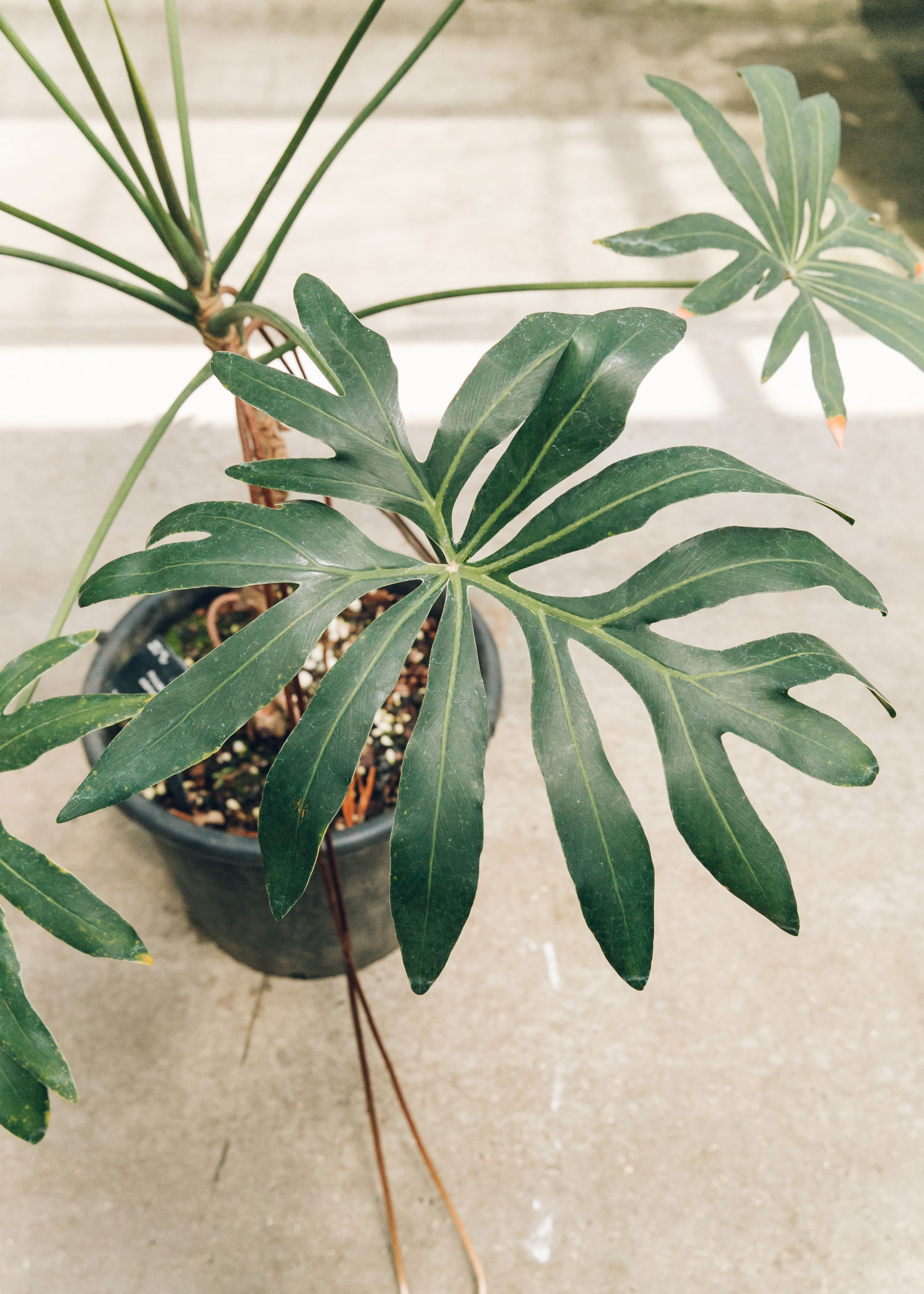

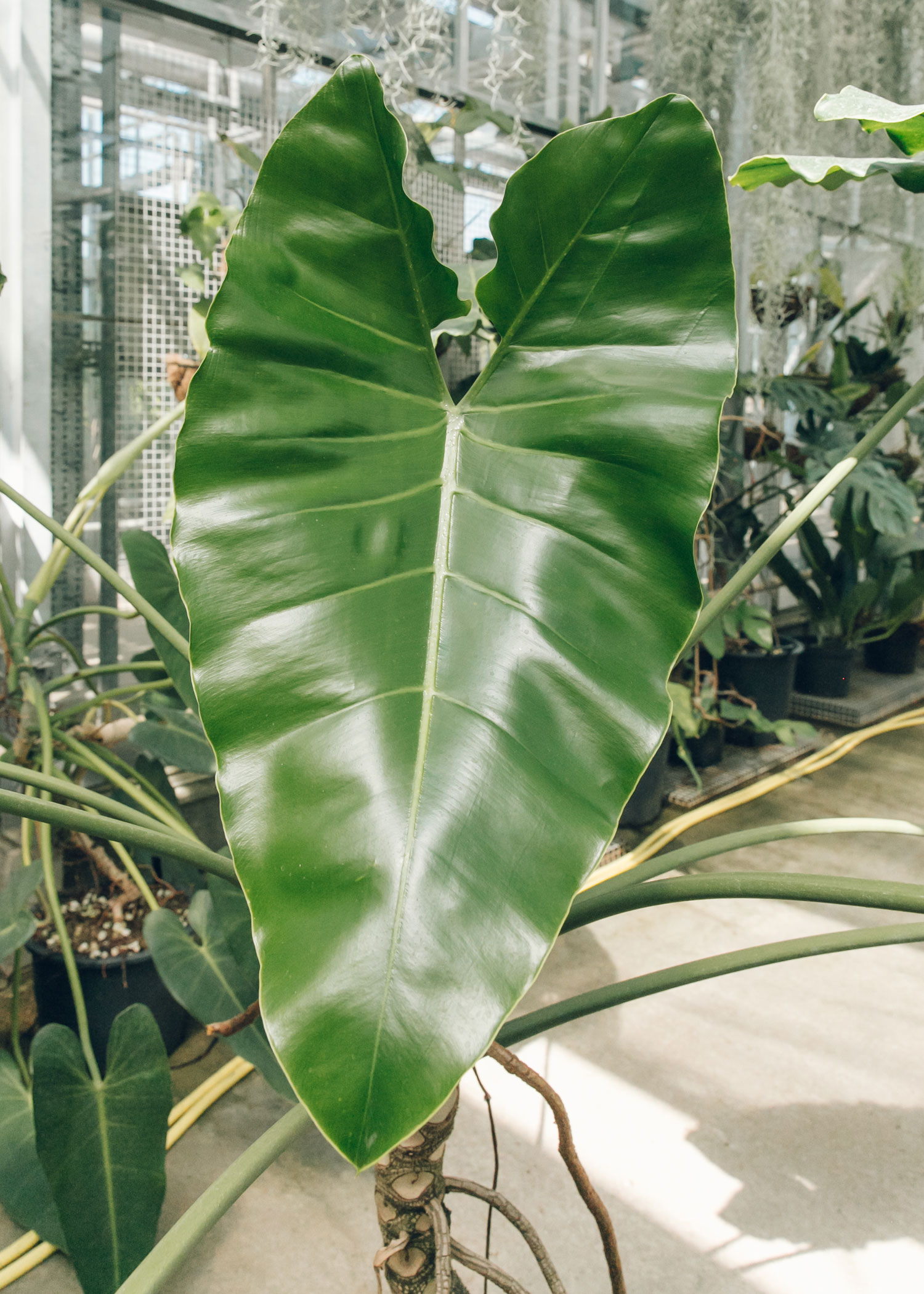
These three species of Thaumatophyllum — T. adamantinum, T. bipinnatifidum and T. solimoesense — are so morphologically distinct that even nonprofessionals can recognize them as different species. Their DNA, however, would be much harder to differentiate at a glance.
Haarkon for Quanta Magazine
But he is by no means anti-technology. Croat is a proponent of digital photography in the field and is interested in the use of specimen photographs in combination with artificial intelligence to create a system that could automatically identify plants as easily as social media algorithms can identify human faces.
Steven Baskauf, a data curation specialist and former principal senior lecturer in biology at Vanderbilt University, has written a paper with Bruce Kirchoff, who studies plant morphology at the University of North Carolina at Greenboro, that describes a set of standards that could be used for shooting photographs of living plants to be archived as specimens. Like Croat and Mayo, Baskauf believes that newer technologies would augment existing botanical practices. Countries and national parks can be extremely strict about the collection of live specimens and sometimes prohibit it altogether, but photographs are allowed. If citizen scientists could add quality images and information to a database (one like iNaturalist, but more robust and rigorous), Baskauf says, it could help botanists expand knowledge about species globally.
The theories and practices of systematics and taxonomy will continue to shift in response to constantly improving technologies that allow us to explore nature in unpredictable ways and at ever greater levels of magnification and molecular detail. It’s within the realm of possibility that some future discovery could change the “lacy tree” plant’s binomial yet again. But for the time being, those of us who have updated our I.D. tags to Thaumatophyllum bipinnatifidum can put away our stamps and Sharpies.
